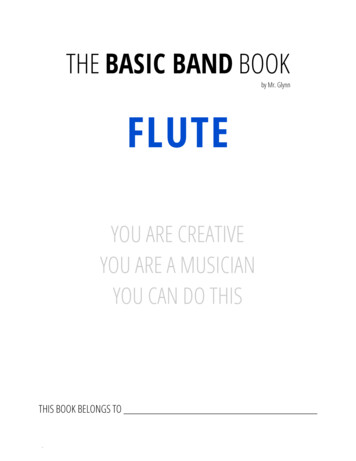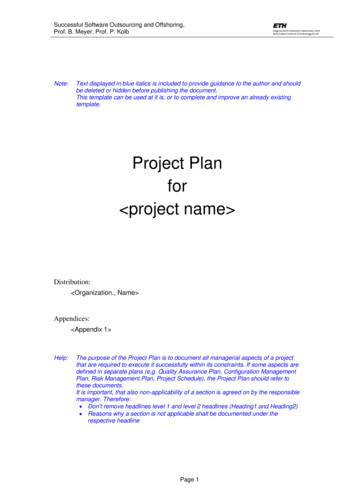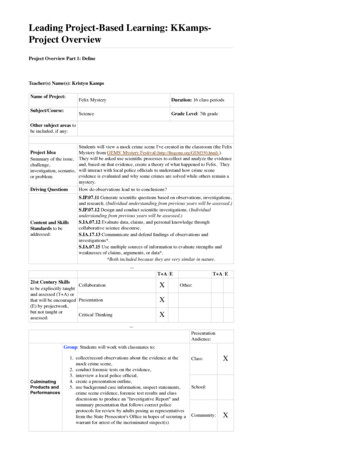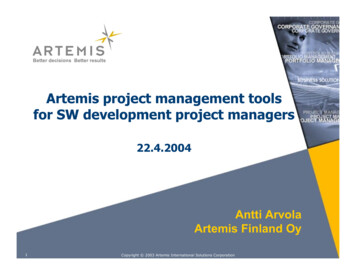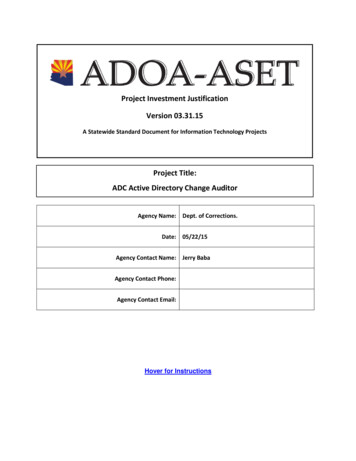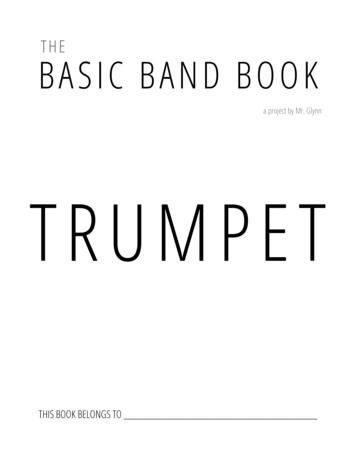
Transcription
THEBASIC BAND BOOKa project by Mr. GlynnTRUMPETTHIS BOOK BELONGS TO
Before we begin YOU AREC R E AT I V EYOU ARE AMUSICIANYOUCAN-3-DOTHIS
THE MUSICAL ALPHABETFORWARDSBACKWARDSE F G A B C D E F G A B CGFAEBCDA-4-BCDEFGFEDCBA
Q & A ––––1) What letter comes after G ?2) When we move forwards in the alphabet, does the sound go up or down?3) When we move backwards in the alphabet, does the sound go up or down?PENCIL GAMES ��–––––––––––WITHOUT looking at the previous page, fill in the missing letters:forwards:1)A D C2)E B Fbackwards:3)C B F A4)F G CBAND @ HOMEwww.BasicBand.info1) Use the video online to help you.2) Say the Musical Alphabet forwards and backwards 5 times in a row perfectlywithout looking at it.3) Challenge your friends and family to say the Musical Alphabet forwards andbackwards and see who can do it well.-5-
BREATH SUPPORTBreath Support: how we use our air to play a wind instrument.Use your stomach to push the air up and out of your body.BUILDING LUNG CAPACITY ) Breathe air IN like you are whispering the letterO2) Breathe air OUT like you are whispering the wordTOEALWAYS DO THIS WITH EXCELLENT POSTUREUSE AS MUCH AIR AS POSSIBLESITTING UP STRAIGHT & TALLKEEP YOUR SHOULDERS RELAXED!-6-
BREATHING EXERCISES ��––At the same speed as the second-hand of a clock:1) Breathe IN for 4 countsOUT for 4 counts2) Breathe IN for 3 countsOUT for 5 counts3) Breathe IN for 2 countsOUT for 6 counts4) Breathe IN for 1 countOUT for 7 countsMAKE UP SOME OF YOUR OWN COMBINATIONS!BAND @ HOMEwww.BasicBand.info1) Carefully cut out the four bulls-eyes on the next page.2) Challenge your friends and family to see who can blow a bulls-eye againstthe wall for the longest amount of time (aim right for the center!).3) Go through the steps above sitting with good posture.-7-
-8-
-9-
- 10 -
SOLFÉGE SYLLABLESMAJORMI NO RREDOTILASOFAMIREDOTILASOFAMIREMEMBER THIS ND @ HOME1) Music always has a resting tone, or thetonic, or the home notewww.BasicBand.info1) Practice speaking through thesolfége syllables forwards andbackwards2) The resting tone in Major tonality is DO3) The resting tone in minor tonality in LA- 11 -
Trumpet Lesson 3PLAYING WITHOUT THE TUNING SLIDEYou can get different pitches from the trumpet without a tuning slide.WHAT TO DO ��–––––––––––––Carefully and slowly pull out thetuning slide and set it down.THE FOUR STEPS ��–––––––––1) Say these words out loud, and put your fingers on your jaw to feel whathappens:OH AH EE2) You should feel your jaw moving up as you say them.3) Buzz a sound on the trumpet and move your jaw up and down like whenyou say those words.4) Carefully put the tuning slide back into the trumpet and repeat thisexercise. You can get many different pitches without pushing down anyvalves.- 12 -
Trumpet Lesson 4PLAYING C & GWHAT TO DO ��–––––––––––––‣ C is the lowest pitch on the trumpet without pushing down valves.‣ G is the the next one higher, still without pushing down valves.Hint: If you can’t get a higher sound,push your lips more together and use faster air.WHAT TO PLAY ��–––––––––––Once you can play a C and a G, play these patterns:1) GCG2) GGG3) CGC4) CCGBAND @ HOMEwww.BasicBand.info1) Go through all of the steps above. Watch the video to help you.2) Don’t forget: Use your stomach to push the air up and out!3) Ask someone at home to give you different combinations of C’s and G’s, andyou show them how to play it.- 13 -
Trumpet Lesson 6TONGUINGTonguing: how we start the sound with the tongueHOW TO TONGUE ��––––––––1) Say the word TOO.2) You will feel your tongue go against the back of your top teeth.3) Say TOO 3 times in a row, connected, then separated.4) Do it again, but with your airstream only (no voice).5) Do this same thing on the trumpet.TROUBLESHOOTING ��––––––‣ Do this exercise, but put your palm in front of your mouth to see if youcan feel air coming out the entire time.- 14 -
CONNECTED ��–––––––––––––Should sound like this:TOOOOOOOO–TOOOOOOOO–TOOOOOOOODon’t breathe in between. This should be one breath out!SEPARATED ��––––––––––––––Should sound like 3 separate silence)BAND @ HOMEwww.BasicBand.info1) Go through all of the steps above. Watch the video online to help you.2) Play both connected and separated rhythms on a G.3) Play different rhythms for someone at home and see if they can tell if it isconnected or separated.- 15 -
TRUMPET FINGERINGSALWAYS REMEMBER ��–––––1) Your hand needs to come down like a claw and push the valves straight down2) Keep your fingers on top of the valves at all times3) Your pinky goes on top of the pinky ring, not under itFINGER POSITION ��––––––––MOUTH PIECE12BAND @ HOME3BELLwww.BasicBand.info1) Use the video online to help you.2) Ask someone to watch you play these notes and have them look to see ifyour fingers are going straight down.- 16 -
ALWAYS REMEMBER ��––––– push down1) What note could come after G? don’t push down2) What note could come before C?openGFED11213openC- 17 -
C is DOMIRECDOTIQ & A ––––1) Is this Major or minor?2) Which note is your resting tone?- 18 -
A is LAMIREDOTIALAQ & A ––––1) Is this Major or minor?2) Which note is your resting tone?- 19 -
F is DOMIREFDOTIQ & A ––––1) Is this Major or minor?2) Which note is your resting tone?- 20 -
D is LAMIREDOTIDLAQ & A ––––1) Is this Major or minor?2) Which note is your resting tone?- 21 -
CHROMATIC SCALECC#ORDbDD#OREb- 22 -E FF#ORGb
GG#ORAbAA#ORBbB CALWAYS REMEMBER ��–––––1) The Chromatic Scale is when you play every note on the instrument, in order,up or down.2) When you go up, use sharps ( # ). When you go down, use flats ( b ).3) It can start and end on any note.- 23 -
MUSIC NOTATIONjust like you take notes to help you remember what yourteacher told you, we also have notes in music. They existto remind you of what you have already learned.It is called Music Notation.BAND @ HOMEwww.BasicBand.info1) Watch the Lesson for Everyone video called “Music Notation” to be sure youunderstand it.- 24 -
STEP 1 – Hold out your hand.5 How many fingers do you have?4How many spaces in betweenthose fingers?4332211STEP 2 –Just like you have lined paper towrite notes on, we also have aspecial type of lines, called amusic staff. The staff has 5 lines, and 4 spacesin between the lines just like yourhand. ��––––––––––––––STEP 3 – Let’s recall some of the solfége syllables:SOFAMIREDOTILA- 25 -
STEP 4 – We can make any line or any space on the staff The picture below showsDOon the imaginary line below the � As long as we know whereeverything else isDODONotes can appear above orbelow the 5 lines. All we have todo is draw an “imaginary” lineis, we can figure out whereSTEP 5 – When we write notes on the music staff, they alternate between lines andspaces:line – space – line – space – line – space – line – space – line Think about what the solfége syllables for the rest of the lines and spacesare going to ��–––––––––––REDO –––TI- 26 -
STEP 6 – Instead of writing the syllables on every line and space, we are going to drawa line to show us where DO isTo tell us which pitch to sing or play, we are going to draw oval notes on itsline or �STEP 7 – The arrow points to DO Write in the rest of the solfége syllables Sing these –––––––––––––––- 27 -
- 28 -
MAJOR TONAL PATTERNSDO is –––––Be expressive when performing with your voice and with your instrument!- 29 -
DUPLE RHYTHM PATTERNS12345678Be expressive when performing with your voice and with your instrument!- 30 -
TRIPLE RHYTHM PATTERNS12345678Be expressive when performing with your voice and with your instrument!- 31 -
- 32 -
PLAYING RECORDOnly check off each day that you spend at least 10 minutes playing your instrument.DATEASSIGNMENT9/5The Musical Alphabet - p. 4M Tu W Th F Sa SuPARENT/GUARDIANSIGNATURER.Glynn- 33 -
3) Buzz a sound on the trumpet and move your jaw up and down like when you say those words. 4) Carefully put the tuning slide back into the trumpet and repeat this exercise. You can get many different pitches without pushing down any valves.
